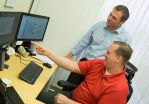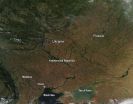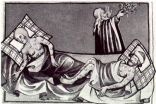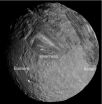(Press-News.org) PULLMAN, Wash. – "Seeking educational curriculum researchers. Humans need not apply."
A Washington State University professor has figured out a dramatically easier and more cost-effective way to do research on science curriculum in the classroom – and it could include playing video games.
Called "computational modeling," it involves a computer "learning" student behavior and then "thinking" as students would. Rich Lamb, who teaches science education at WSU's College of Education, said the process could revolutionize the way educational research is done.
Lamb's research has just been published in Computers & Education journal. The article describes how computers examine student responses to science tasks – such as comparing liquid volumes – and thereafter mimic the way students think.
"Traditionally, we'd be confined to a classroom to study student learning for virtually every potential theory we have about science education and curriculum implementation," Lamb said. "But now, instead of taking a shotgun approach, we can test the initial interventions on a computer and see which ones make the most sense to then study in the classroom."
So in-person research becomes more finely targeted and requires fewer student subjects. It requires less time from researchers and costs less money.
"In the current model of research, we go into a classroom and spend months observing, giving tests and trying to see if changes to a specific model work and how to best implement them," Lamb said. "It will still be necessary for researchers to go into the classroom; hopefully that never goes away. This just gives us more flexibility."
Video games method
An artificial neural network is basically artificial intelligence that simulates the human brain. Lamb and his fellow researchers, including college colleagues Tariq Akmal and Kathy Baldwin, use an artificial neural network they named the Student Task and Cognition Model.
Students were given tasks to complete in an electronic game. The tasks were scientific in nature and required students to make a choice. The researchers used statistical techniques to track everything and assign each task as a success or failure.
"The computer is able to see what constitutes success, but it's also able to see how students approach science," Lamb said.
Because the computer is learning an approach to science, rather than just how to do a specific task, it will later try to solve a different problem the same way a student might.
"I've enjoyed this research in particular because it's opening new understandings of learning and new avenues of teaching and assessment as a result," said David Vallett, one of Lamb's co-researchers from the University of Nevada Las Vegas. "It's a novel yet practical blend of cognitive science and education."
Testing multiple models at once
Lamb said most entertainment video games have the same characteristics as educational videos games. So long as it asks a singular task of the students, any game would suffice – Halo, Call of Duty, Mario Kart and more.
"The computer is learning to solve novel or new problems, which means we can test different educational interventions before ever getting to a classroom," he said.
He said those initial tests will not only tell researchers if a specific educational model will work, but will give a specific percentage of success.
"Even with a large research team, it's usually too difficult to test more than one intervention at a time," he said. "Now we can run multiple interventions, choose the one that looks like it will work the best and then just test that one."
Significant cost savings
And that will help the bottom line.
"For me to get 100,000 students, teachers to administer tests, professors doing research and all the rest, we could easily look at about $3.5 million," Lamb said. "We can now get those 100,000 students for the cost of running software off a computer."
It's definitely a novel approach. And it is sure to get a few raised eyebrows. But Vallett said he wouldn't expect any less from Lamb.
"Rich is an enthusiastically creative researcher and statistician," Vallett said. "That creative spark is what sets him apart from most of the field; he's not satisfied with merely adding a sliver of understanding to our existing knowledge of a topic."
INFORMATION: END
Video games could dramatically streamline educational research
Computers 'learn' student behavior and 'think' as students would
2014-09-18
ELSE PRESS RELEASES FROM THIS DATE:
Tree rings and arroyos
2014-09-18
Boulder, Colo., USA – A new GSA Bulletin study uses tree rings to document arroyo evolution along the lower Rio Puerco and Chaco Wash in northern New Mexico, USA. By determining burial dates in tree rings from salt cedar and willow, investigators were able to precisely date arroyo sedimentary beds 30 cm thick or greater. They then combined this data with aerial imagery, LiDAR, longitudinal profiles, and repeat surveys to reconstruct the history of these arroyos.
Arroyos are deep, oversized channels that have vertical or steeply cut walls made up of silt, clay, or sand. ...
Spouse's personality influences career success, study finds
2014-09-18
As people spend more and more time in the workplace, it's natural for co-workers to develop close bonds — what's often referred to as a "workplace spouse" or an "office wife."
But when it comes to pay raises, promotions and other measures of career success, it's the husband or wife at home who may be exerting a bigger influence on workplace performance, suggests new research from Washington University in St. Louis. "Our study shows that it is not only your own personality that influences the experiences that lead to greater occupational success, but that your spouse's ...
Marcellus drilling boom may have led to too many hotel rooms
2014-09-18
Drilling in Pennsylvania's Marcellus Shale region led to a rapid increase in both the number of hotels and hotel industry jobs, but Penn State researchers report that the faltering occupancy rate may signal that there are now too many hotel rooms.
"Demand is still high in many of the counties in the Marcellus Shale region, but the occupancy rate is starting to come down," said Daniel Mount, an associate professor in hospitality management. "The case could be made that this is a sign that hotels were overbuilt."
Marcellus drilling operations generated approximately $685 ...
Survey: Fortune 500 employees can expect to pay more for health insurance
2014-09-18
Employees working for Fortune 500 companies can expect to pay higher employee contributions for their health insurance, according to a survey of chief human resource officers about the impact of the Patient Protection and Affordable Care Act (also known as PPACA or Obamacare) conducted by the Darla Moore School of Business at the University of South Carolina this past May/June.
Patrick Wright, a professor in strategic human resource management, directs the annual the HR@Moore Survey of Chief HR Officers. The survey is distributed to more than 560 CHROs of Fortune 500 ...
Agricultural fires in the Ukraine
2014-09-18
Numerous fires (marked with red dots) are burning in Eastern Europe, likely as a result of regional agricultural practices. The body of water at the lower left of this true-color Moderate Resolution Imaging Spectroradiometer (MODIS) image is the Sea of Azov. The Sea is bordered by Ukraine to the northwest, west and southwest and by Russia to the northeast, east, and southeast. To its left is the Black Sea.
The location, widespread nature, and number of fires suggest that these fires were deliberately set to manage land. Farmers often use fire to return nutrients to the ...
Professional recommendations against routine prostate cancer screening have little effect
2014-09-18
DETROIT – The effect of guidelines recommending that elderly men should not be routinely screened for prostate cancer "has been minimal at best," according to a new study led by researchers at Henry Ford Hospital.
The study, published as a research letter online in JAMA Internal Medicine, focused on the use of PSA – prostate-specific antigen – to test for prostate cancer.
"We found that the effect of the guidelines recommending against the routine screening of elderly men in particular has been minimal at best," says Jesse Sammon, D.O., a researcher at Henry Ford's Vattikuti ...
New insights on an ancient plague could improve treatments for infections
2014-09-18
DURHAM, N.C. – Dangerous new pathogens such as the Ebola virus invoke scary scenarios of deadly epidemics, but even ancient scourges such as the bubonic plague are still providing researchers with new insights on how the body responds to infections.
In a study published online Sept. 18, 2014, in the journal Immunity, researchers at Duke Medicine and Duke-NUS Graduate Medical School Singapore detail how the Yersinia pestis bacteria that cause bubonic plague hitchhike on immune cells in the lymph nodes and eventually ride into the lungs and the blood stream, where the infection ...
Sensing neuronal activity with light
2014-09-18
For years, neuroscientists have been trying to develop tools that would allow them to clearly view the brain's circuitry in action—from the first moment a neuron fires to the resulting behavior in a whole organism. To get this complete picture, neuroscientists are working to develop a range of new tools to study the brain. Researchers at Caltech have developed one such tool that provides a new way of mapping neural networks in a living organism.
The work—a collaboration between Viviana Gradinaru (BS '05), assistant professor of biology and biological engineering, and ...
No sedative necessary: Scientists discover new 'sleep node' in the brain
2014-09-18
BUFFALO, N.Y. – A sleep-promoting circuit located deep in the primitive brainstem has revealed how we fall into deep sleep. Discovered by researchers at Harvard School of Medicine and the University at Buffalo School of Medicine and Biomedical Sciences, this is only the second "sleep node" identified in the mammalian brain whose activity appears to be both necessary and sufficient to produce deep sleep.
Published online in August in Nature Neuroscience, the study demonstrates that fully half of all of the brain's sleep-promoting activity originates from the parafacial ...
Miranda: An icy moon deformed by tidal heating
2014-09-18
Boulder, Colo., USA – Miranda, a small, icy moon of Uranus, is one of the most visually striking and enigmatic bodies in the solar system. Despite its relatively small size, Miranda appears to have experienced an episode of intense resurfacing that resulted in the formation of at least three remarkable and unique surface features -- polygonal-shaped regions called coronae.
These coronae are visible in Miranda's southern hemisphere, and each one is at least 200 km across. Arden corona, the largest, has ridges and troughs with up to 2 km of relief. Elsinore corona has ...
LAST 30 PRESS RELEASES:
How to make AI truly scalable and reliable for real-time traffic assignment?
Beyond fragmented markets: A new framework for efficient and stable ride-pooling
Can shape priors make road perception more reliable for autonomous driving?
AI tracks nearly 100 years of aging research, revealing key trends and gaps
Innovative techniques enable Italy’s first imaging of individual trapped atoms
KIER successfully develops Korea-made “calibration thermoelectric module” for measuring thermoelectric device performance
Diversifying US Midwest farming for stability and resilience
Emphasizing immigrants’ deservingness shifts attitudes
Japanese eels, climate change, and river temperature
Pusan National University researchers discover faster, smarter heat treatment for lightweight magnesium metals
China’s 2024 Gastroenterology Report: marked progress in endoscopy quality and disease management
Pusan National University researchers uncover scalable method for ultrahigh-resolution quantum dot displays
Researchers use robotics to find potential new antibiotic among hundreds of metal complexes
Gut bacteria changes at the earliest stages of inflammatory bowel disease
Scientists develop new way to “listen in” on the brain’s hidden language
Brain research: “Pulse generators” grow and shrink as memories are formed
For teens, any cannabis use may have impact on emotional health, academic performance
School meals could unlock major gains for human and planetary health
Menopause hormone therapy does not appear to impact dementia risk
Signature patterns of brain activity may help predict recovery from traumatic brain injury
Dresden study uncovers new key mechanism in cancer cells
New species are now being discovered faster than ever before, study suggests
Cannabis-based products show limited short-term benefit for chronic pain, with increased risk of adverse effects
Cannabis products with more THC slightly reduce pain but cause more side effects
Clearing the brain of aging cells could aid epilepsy and reduce seizures
Brain injuries linked with potential risk of suicide, new study finds
New technique lights up where drugs go in the body, cell by cell
New study finds movement of fishing fleets can reveal shifts in marine ecosystems
Embargoed: New evidence points to potential treatment for vascular dementia
Study uncovers disrupted brain balance in alcohol dependence
[Press-News.org] Video games could dramatically streamline educational researchComputers 'learn' student behavior and 'think' as students would








